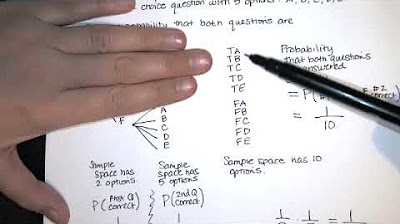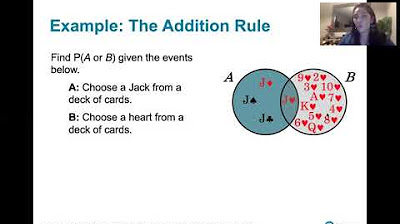Multiplication & Addition Rule - Probability - Mutually Exclusive & Independent Events
TLDRThe video explains two fundamental rules of probability: the addition rule and the multiplication rule. The addition rule calculates the probability of event A or B occurring, while the multiplication rule calculates the probability of A and B occurring together. These rules are applied in an example where a student is deciding between taking algebra and biology courses. The probability of taking both or either course is calculated using the formulas. It's determined the events are not independent or mutually exclusive based on the probability values. The summary highlights key takeaways about calculating probability using these two important rules.
Takeaways
- 😀 The addition rule: P(A or B) = P(A) + P(B) - P(A and B)
- 😎 The multiplication rule: P(A and B) = P(A given B) * P(B)
- 🤓 Conditional probability: P(A given B) = P(A and B) / P(B)
- 🧐 If A and B are independent events, P(A and B) = P(A) * P(B)
- 👍 Order doesn't matter for P(A and B) vs P(B and A)
- 📝 Use addition rule if given P(A), P(B), P(A and B)
- 📚 Use multiplication rule if given P(A given B) and P(B)
- 😉 Events are independent if P(A given B) = P(A)
- ❌ Events are mutually exclusive if P(A and B) = 0
- 📈 Apply formulas to calculate probabilities of combined events
Q & A
What is the formula for calculating the probability of event A or event B occurring?
-The formula is P(A or B) = P(A) + P(B) - P(A and B).
When can you use the simplified formula P(A or B) = P(A) + P(B)?
-You can use the simplified formula when A and B are mutually exclusive events, meaning they cannot occur at the same time.
What is conditional probability?
-Conditional probability is the probability of one event occurring given that another event has already occurred. It is calculated as P(A given B) = P(A and B) / P(B).
How are the formulas P(A and B) = P(A given B)*P(B) and P(A and B) = P(B given A)*P(A) related?
-These two formulas are related because P(A and B) is the same regardless of order. They allow you to calculate P(A and B) if given information about conditional probabilities.
When can you use the formula P(A and B) = P(A)*P(B)?
-You can use this formula when A and B are independent events. In that case, the occurrence of one event does not affect the probability of the other event.
In the example, are enrolling in algebra and enrolling in biology independent events?
-No, they are not independent because P(algebra given biology) does not equal P(algebra). The probability of taking one course affects the probability of taking the other.
In the example, what is the probability Sarah enrolls in both algebra and biology?
-The probability she enrolls in both is 0.28 or 28%.
In the example, are algebra and biology mutually exclusive events?
-No, they are not mutually exclusive because the probability of Sarah taking both courses is not 0. She can take both courses.
What does order not being relevant for P(A and B) mean?
-It means that P(A and B) = P(B and A) because the events occur simultaneously, so which event is labeled A and which is B does not matter.
What information is needed to determine if two events A and B are independent?
-You need to know P(A), P(B), and P(A given B). If P(A given B) equals P(A), then A and B are independent events.
Outlines
😊 Addition and Multiplication Rules of Probability
This paragraph explains two basic rules of probability - the addition rule and the multiplication rule. The addition rule states that the probability of A or B occurring is the probability of A plus the probability of B minus the probability of A and B together. The multiplication rule relates to conditional probability - the probability of A and B occurring is the probability of A given B times the probability of B. These rules apply regardless of whether events are independent or mutually exclusive.
😃 Applying Probability Rules to Course Enrollment Scenario
This paragraph applies the probability rules to a scenario where Sarah is deciding which college courses to enroll in. Given probabilities related to enrolling in algebra and biology, calculations are done to determine: the probability she takes both courses, the probability she takes algebra or biology, whether the events are independent, and whether they are mutually exclusive.
Mindmap
Keywords
💡Addition Rule
💡Mutually Exclusive Events
💡Multiplication Rule
💡Conditional Probability
💡Independent Events
💡Probability
💡Event
💡Overlap
💡Equation Rearrangement
💡Joint Probability
Highlights
First significant highlight text
Second notable highlight text
Transcripts
Browse More Related Video

4.2.1 Addition and Multiplication Rules - Simple and Compound Events, and Their Probabilities

Probability Formulas, Symbols & Notations - Marginal, Joint, & Conditional Probabilities

AP Stats Test Quick Review: Probability

Elementary Stats Lesson #8

4.2.5.1 Addition and Multiplication Rules - The Rationale Behind the Multiplication Rule

4.2.2 Addition and Multiplication Rules - The Addition Rule
5.0 / 5 (0 votes)
Thanks for rating: